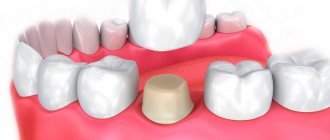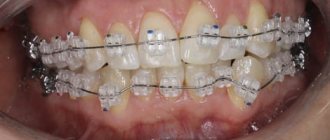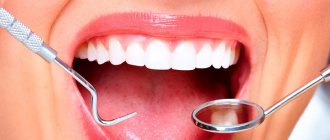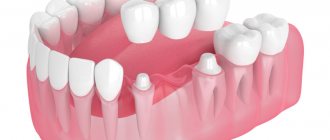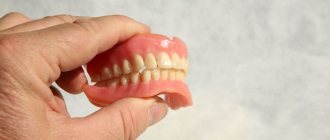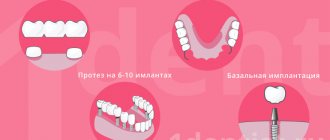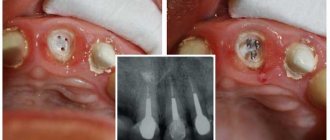Replacing missing teeth - even those located in the invisible part of the mouth, that is, not in the smile line - is extremely important to restore chewing ability, as well as maintain the contour of the face and the aesthetics of the smile. Today, in this article, Estet Dentistry will answer the question, “a metal-ceramic crown if there is no tooth.” This question can be attributed to any type of crown, due to the fact that the problem of this issue lies precisely in the absence of a tooth and ways to solve this problem.
At the moment, there are several ways to solve the problem of missing 1 tooth, namely:
- Installation of an implant of 1 tooth
- Installation of a bridge for 1 tooth
- Installation of a removable cosmetic prosthesis for 1 tooth
- Extending a tooth onto a pin and then closing it with a crown (if there is a root)
- Installing a pin into the root of the tooth and a crown on it (if there is a root)
Which prosthesis to put if the tooth root is removed - we consider all the options and choose the best one
Article navigation
- Indications for removal along with the root
- Prosthetic methods
- Removable dentures
- - for single defects
- - there are not many teeth
- - with complete edentia
- Fixed dentures supported by your teeth
- Supported by implants
- — restoration of 1-2 teeth
- - from 3 missing teeth in a row
- - full recovery
- Which way is better?
Question for a specialist
Many people, for one reason or another, lose teeth - one or several at once, or all, but gradually. This is often caused by injuries, aggressive caries, general diseases of the body, and even the fear of going to the dentist for treatment. But it is necessary to have prosthetics, otherwise problems with the gastrointestinal tract will begin, early wrinkles will appear, not to mention the unaesthetic appearance of the smile. Next, we will tell you what methods are used for prosthetics of teeth without roots - and which option is considered optimal.
Indications for removal along with the root
No dentist will remove a tooth just like that, since each one is important for the normal functioning of the dental system - doctors still try to preserve them. To do this, fillings or restorative inlays, crowns, pins and stump inlays are placed in the root canals. So is it necessary to remove tooth roots before getting dentures? Yes, indeed, sometimes situations arise that removal is the only option, otherwise complications are possible - up to infection of the jaw bone or loss of all units in a row.
Let's consider cases when deletion is indispensable:
- the presence of vertical cracks in the roots,
- irreparable perforations in the root wall or in the bifurcation area (the place where the roots begin to branch under the crown),
- presence of a piece of dental instrument in the root canal that cannot be removed,
- chipping of the crown deep under the gum: in this case, placing a filling or core inlay may be problematic due to the damp environment around - such a restoration will not last long,
- the presence of neoplasms under the roots (cysts, granulomas) that cannot be eliminated without removal,
- destruction or complete dislocation due to injury: blow, bruise, gnawing something hard,
- inability to go through root canals with an instrument due to their non-standard shape,
- osteomyelitis of the jaw: if osteotomy (cutting off) of pathological areas of the bone is required,
- severe loss of bone and gums against the background of the late stages of periodontitis and periodontal disease: here the teeth become very mobile, and tartar builds up along the roots - an infectious focus arises, which leads to inflammation and toxic damage to the surrounding tissues (gums and jaw bone).
Removable dentures (traditional)
- When to place: in the absence of any number of teeth - one, several or all.
- Duration and features of wearing: temporary prosthetics, the prosthesis will last 3-5 years. They are relevant if there are contraindications to fixed prosthetics - pregnancy, in childhood, with serious diseases of the body (when it is not recommended to give anesthetic injections and perform surgical interventions), with a small budget for treatment.
OPERATIVE PROSTHETICS WITH ACRYLIC PROSTHETICS - from RUR 180,000.
Re-prosthetics with an acrylic bridge on a metal frame (all included) up to 12 units.
Save RUR 30,000. Call now or request a call
As a rule, removable dentures supported by gums or remaining teeth cannot provide high aesthetics, since their fastenings in the form of hooks (especially metal ones) are visible from the side. It is difficult to chew food with them, because... fixation is unreliable. Most removable dentures dent due to softness, loose fit, or rub the gums to the point of ulcers and injure the supports. Also, structures often fall out of the mouth while eating or talking. Therefore, patients have to use a cream to adhere the base to the gums (for example, Corega or Protefix).
Removable prosthetics for single defects
If we consider the situation that the patient is missing only 1-2 teeth along with the root, then the orthopedic dentist can offer “butterfly” prosthetics. This is a miniature orthopedic structure consisting of artificial crowns, surrounding artificial gums and hooks along the edges, which are fixed to adjacent dental crowns (natural). It is very difficult to chew food normally, so you should choose this solution only on a temporary basis.
If you don't have a lot of teeth
Here they install more massive versions of removable structures - for example, clasp ones (on hook-clasps, clasps-attachments or telescopic crowns). Their advantage is that they distribute the chewing load quite well due to the presence of a metal arch - a clasp, and also have a small palatal bridge.
For the same indications, you can install classic acrylic removable dentures with hooks for fixation on the remaining teeth. Or nylon - they are more convenient, because... the material is elastic, but stretches over time and cannot be repaired. Removable structures Acry-free (“Acry-free”), Quattro Ti (“Quadrotti”), and sandwich dentures are considered more comfortable to wear compared to conventional acrylic ones.
It is worth mentioning separately about “Quadrotti”, which are considered metal-free analogues of clasp ones. They, like the “clasps”, do not have a large palatal overlap, but only a thin bridge. The remaining removable structures will be equipped with a massive sky - and the fewer units left in the row, the more massive it is.
Removable prosthetics with complete edentia
If all the teeth are missing along with roots suitable for prosthetics, clasp structures can no longer be placed, just like sandwich dentures. The patient can choose between other removable ones - acrylic, nylon, polyurethane and Acry-free. Since the prosthesis is attached only to the gums and only due to the “suction cup effect,” the quality of fixation of such products leaves much to be desired. Many patients often say that they cannot get used to the massive prosthetic structure (because they begin to feel sick or produce a lot of saliva) or are completely unable to chew with it. That is, such an artificial “jaw”, at best, can provide the beauty of a smile, but you can forget about functionality.
Learn more about taking medications before dental implants
Since prosthetics are most often needed by older people who have chronic diseases, the relevant question is: what do you need to know about taking medications when preparing for dental implantation before surgery? There are specific recommendations on this matter:
- Tell your implantologist if you are taking blood pressure medications. If your blood pressure is not normal due to anxiety, you may need medication prescribed to you before implantation. The doctor must know all the nuances and be prepared for any development of events. Therefore, come to the clinic 30-40 minutes before the operation so that, if necessary, take the drug and wait for it to take effect.
- If the sugar level deviates from the norm, patients are prescribed anticoagulants, which are strictly prohibited before any surgical procedures. Aspirin and other blood thinners may cause bleeding after implantation. Discuss this issue with your endocrinologist to find a solution and understand how to stop taking anticoagulants, at least for the day of surgery.
- When preparing for dental implantation, you need to stop all intensive care activities. If you are taking a lot of medications and cannot yet stop taking them, inform the implantologist about this and he will reschedule the operation for a more convenient period.
It is impossible to list all the nuances in one universal recommendation. Therefore, be sure to inform your dentist about the list of medications you are taking. He, based on individual indications, will decide whether surgery is indicated without giving up specific medications or not.
Fixed dentures supported by your teeth
- When to place: if 1-4 teeth are missing in a row, and at least 1 healthy tooth or root should be preserved on each edge of the “empty” space. We are talking about dental bridges or bridge-like prostheses.
- Wearing period: in most cases, this is a permanent fixed prosthesis, so such a prosthesis will last approximately 5-7 years.
The most popular method of prosthetics after root removal is a bridge structure or, more simply, a dental bridge. These are several artificial crowns connected in a row. Moreover, the central ones replace missing natural crowns (there are no roots under them), and the outer ones are fixed on natural teeth or their roots. That is, in order to restore 1 extracted tooth, you need to use two adjacent ones for support. Which does not have a very good effect on their service life. After all, the supports need to be sharpened, the “nerves” (neurovascular bundles) removed from them - so they receive less useful substances in the future.
There is a temporary version of the bridge structure - this is an adhesive bridge. It does not have end crowns, but instead there are plates or “wings” on the sides of the artificial crown that are glued to the abutments on one side. However, the fixing composition and shape of the fasteners cannot provide a reliable connection for many years. Therefore, adhesive bridges often come off when chewing.
The advantage of bridges is that they are highly aesthetically pleasing – especially those made, for example, from E.max ceramics from Ivoclar Vivadent, glass ceramics from VITA Zahnfabrik or Prettau zirconia. Metal-ceramic crowns during operation reduce the aesthetics of a smile, because... may cause “blueness” of the gums. If you choose metal ceramics, it is better to give preference to quality brands. For example, IPS Classic from Ivoclar Vivadent, Duceram from Dentsply Sirona, and Kuraray Noritake.
Requirements for the surviving part
Unfortunately, fixing the prosthesis to the tooth root is not always possible. To do this, the latter must satisfy a number of requirements:
- have strong walls and be long enough;
- not be affected by caries;
- be well passable (otherwise it will not be possible to seal it);
- have walls of the required thickness to hold the inserted pin and withstand the pressure exerted during chewing food;
- do not have inflammatory changes in the upper part.
If the root is very curved, it is very small in size, it will not be possible to use it during prosthetics. The situation is similar if there are fistulas in the gums that do not go away even after filling.
Implant supported dentures
- When to place: in the absence of any number of teeth - one, several or all.
- Duration and features of wearing: permanent prosthetics, the prosthesis will last 10-20 years (then you need to change it), and implants last a lifetime (they do not need to be changed if they are installed correctly and correctly, and you monitor the condition of the oral cavity).
All of the above methods of removable and fixed prosthetics do not restore missing tooth roots, but only missing crowns. But implants are just analogues of tooth roots. That is, implantation can be called a complete restoration of both the root and the coronal part.
PROSTHETICS WITH 6 OSSTEM IMPLANTS FROM RUB 220,000.
Complex implantation Osstem (South Korea) with delayed loading after 4-6 months.
Call now or request a call
First, the implants are installed. Then prosthetics occurs - but depending on the situation, prostheses can be different (removable and non-removable) and placed at different times after implantation. Let's look at the most popular cases next.
The advantages of dentures on implants include very reliable fixation - you can chew and talk without fear that they will move or fall out. Another plus is that the chewing pressure is distributed physiologically from the crown to the implant and further to the bone tissue. That is, all teeth in a row (both natural and on implants) equally participate in the act of chewing, without overloading individual areas. Therefore, orthopedic structures last 2-3 times longer. The only downside is the high cost of treatment.
Restoration of 1-2 teeth
For single restorations1, one dental implant is placed under each crown. Moreover, the implant can be placed immediately after removal, for example, of a destroyed incisor, i.e. without waiting for the hole to heal. After implantation, you need to give the implants time to take root, fuse with the bone tissue - undergo osseointegration. On the lower jaw this process takes an average of 3 months, on the upper jaw up to six months. After this, a permanent crown is placed on the implant, and during the healing process the patient wears a temporary crown, removed from the bite (so that the implant is not overloaded), or an adhesive bridge.
For crowns on implants, it is preferable to use metal-ceramics or zirconium dioxide, because regular ceramics are too fragile. When installed on metal abutments (connecting elements between the prosthesis and the implant), the ceramic begins to crumble under load.
Some implant manufacturers, for example, Nobel Biocare and Straumann, make the surfaces of products chemically active by applying substances that stimulate the growth of bone tissue. In this case, osseointegration follows an accelerated “scenario” and prosthetics can be installed not after 3-6 months, but after only 2-6 weeks.
Restoration of 3 missing teeth in a row
For large defects, it is recommended to install a bridge on implants. Moreover, if you use progressive models with active surfaces, then you can install a permanent bridge on implants in the shortest possible time. Even 3-5 days after implantation, because... the bridge-like structure will additionally splint the implants from above and prevent them from moving under load (the more teeth there are missing, the greater the possibility of immediate loading - but here you still need to look at the situation).
Complete restoration of the dentition
If the patient has complete edentia - that is, the absence of all teeth in a row along with the roots, then the dentist may offer to install removable or fixed dentures on implants. To support them, from 3 to 14 implants are installed per jaw - everything depends on the quality and volume of bone tissue, as well as the presence of inflammatory processes.
Previously, patients had only one option for implantation - with delayed prosthetics, when they had to wait 3-6 months for implants to take root, and only then get dentures. Nowadays, implantation techniques with immediate loading are gaining popularity - All-on-4, All-on-6, basal and zygomatic implantation, when prosthetics occur immediately or 3-4 days after surgery.
Read on the topic: implantation and prosthetics using the All-on-4 method is one of the best options to get a perfect smile in 1 day.
Contraindications and cost
Before inserting a tooth in place of an extracted one, the orthopedist must find out whether implantation is contraindicated for the patient. The manipulation is not carried out if the patient has a chronic pathology or low blood clotting. After a heart attack, implantation is contraindicated. The operation is also not performed in the following cases:
- post-infarction state;
- any stage of alcoholism and drug addiction;
- pregnancy.
The cost depends on the country of manufacture of the orthopedic structure, which tooth fell out, and how many units need to be restored. The average price of an implant is offered by manufacturers from America and Israel, the lowest - from the CIS countries, and the highest - from Switzerland and Germany. The price range for 1 unit is 15-30 thousand rubles. For the entire procedure, the patient will pay about 40 thousand rubles. This amount includes the work of a specialist and the cost of implantation.
Which method is better to choose?
When choosing a smile restoration method, you should rely not only on its cost, but also on the comfort of use. Here, fixed prostheses on implants simply have no competitors. About 90% of patients, even 5-10 years after implantation, declare that their quality of life is as high as that of people with their own teeth. That is, the diet is varied, there is no pain and inflammation in the dental system, and the smile maintains high aesthetics. Many people note that their face looks younger and that facial wrinkles have smoothed out.
Whereas 60% of people who chose classic removable structures say that if they knew how uncomfortable dentures are, how they rub and do not protect against bone loss, they would look for better quality prosthetics or implantation. Those who wear bridges, 5-7 years after their installation, begin to regret that they “ruined” healthy supporting teeth, and now they have collapsed from overload. As a result, they had to be removed and a longer bridge or removable denture installed.
“Mom tried to wear a removable jaw for several years, but for some reason it didn’t suit her. She says that it is very uncomfortable with her. You can't do anything except smile. And it’s generally impossible to eat. My brother and I decided to give her an anniversary gift. We found a good clinic and persuaded my mother to undergo All on Four implantation. She, of course, was afraid at first, but then she appreciated it. He says he should have done this earlier and not have suffered.”
Julia P., review from prodoctorov.ru
Therefore, it is better to place 1 crown on an implant than a classic bridge - and these methods are comparable in price. A fixed prosthesis is better than a removable one, because... more convenient, firmly fixed and small in size, which makes it easier to get used to, care and use. But, of course, it is also important to evaluate your health and financial capabilities, together with a competent doctor, so that the type of prosthetics really suits you.
1Martin U., Chappuis V. Implantological treatment in an aesthetically significant area. Modern protocols for single tooth replacement, 2019.
Your questions and answers
QUESTION Hello, I have a problem with my front tooth. Almost every two years I treat him, but the caries comes back again. Moreover, the dentist said last time that, most likely, it would have to be removed along with the root. Which prosthesis is better to install? Alexei
ANSWER Hello, Alexey. The best option is to install an implant with a zirconium dioxide crown. This way you will fully restore the extracted tooth. By the way, you can even do one-stage implantation, i.e. place an implant on the day of removal of a damaged tooth. Another option, but of lower quality, is a bridge. But the bridge will have to rest on something, in this case it will be necessary to use 2 adjacent healthy teeth for support. As a result, they will irreversibly lose part of the enamel due to grinding, and the dental “nerve” will also be removed. Also, the supports will experience increased load and fail faster.
Author: Chorny S.V. (Thank you for your help in writing the article and the information provided)
Patient reviews
Due to calcium deficiency, the masticatory and anterior units began to crumble rapidly. I turned to the dentist for help late. I had to order a prosthesis for the entire jaw. Easy to remove and does not cause allergies. The procedure for sanitation of the oral cavity itself was painless.
Andrey, 54 years old
Due to neglect, I lost 2 chewing teeth in my youth. I had to insert new ones. I chose a domestic manufacturer. The system is made of titanium, so it has taken root well. I've been wearing my new teeth for over a month.
Svetlana, 39 years old
I accidentally knocked out a tooth.
I had to undergo implantation. First, they treated my gum and screwed in a pin. Then an Israeli-made crown was installed with the new root. The procedure lasted 2 months. There were no adverse reactions. I am satisfied with both the specialists and the chosen material. Anton, 29 years old
